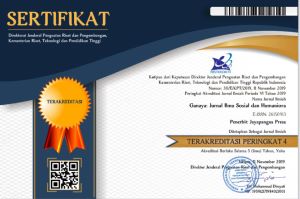Analisis Isi Kekerasan Seksual di lembaga Pendidikan Pada Laman Kompas Online
DOI:
https://doi.org/10.37329/ganaya.v6i4.2747Keywords:
Sexuality, Students, School, Power RelationsAbstract
This study aims to describe the characteristics and forms of sexual violence in educational institutions reported on the Kompas Online page for the 2018-2022 period. This research uses descriptive quantitative content analysis method. The object studied was news of sexual violence in educational institutions for the period 2018-2022. Samples were taken using total sampling totaling 100 news cases. The results showed that all perpetrators of sexual violence in educational institutions reported were male (100%), and most victims of sexual violence were female (81%). Furthermore, the perpetrators of sexual violence are mostly dominated by teachers (43%). This is related to the unequal power relations between perpetrators and victims. Then, most sexual violence occurs in elementary schools (29%) due to several factors, such as victims tend to be innocent, have low knowledge about sex education, low levels of courage due to pressure or threats. Regarding the relationship between education level and forms of sexual violence, it shows that touching/poking, and touching in sensitive areas (breasts, genitals, etc.) occurred mostly in elementary schools (69.0%) and universities (45.5%). In addition, coercion of sexual intercourse outside of legal marriage occurred mostly at the high school (54.5%), junior high school (52.2%), and Islamic boarding school (46.7%) education levels. Then, in the category of the relationship between the perpetrator and the victim, which is dominated by teachers as perpetrators, it turns out that many commit sexual violence in the form of touching / poking and touching in sensitive areas (breasts, genitals, and others) (55.8%). This was done by the perpetrators to fulfill their sexual satisfaction by means of persuasion, the lure of gifts, and threats so that their victims, who were students, could be influenced and tricked.
References
Andini & Faridah. (2022). Tinjauan Kriminologi Mengenai Ketimpangan Relasi Kuasa Dan Relasi Gender Dalam Kasus Kekerasan . Jurnal Ilmu Hukum dan Humaniora, 9 (5), 2279-2292.
Aprilita. (2012). Faktor-Faktor Penyebab Perilaku Pelecehan Seksual Pada Remaja. PhD Thesis Universitas Airlangga.
Carrabine, dkk. (2004). Criminology A Sociological Introduction. New York: Phsycology Press.
Conell & James. (2013). Maskulinitas Hegemonik. Majalah Studi Feminis, 21 (1), 424.
Fleming,dkk. (2016). Men's Violence Against Women and Men Are Inter-Related: Recomendation For Simultaneus Intervention. Social Science & Medicine, 249-256.
Foucault. (2000). Power (Essential Work Vol. 3). New York: New Press.
Gazali. (2013). Optimalisasi Peran Lembaga Pendidikan Untuk Mencerdaskan Bangsa. Jurnal Al-Tabib, 6(1), 127-136.
Jamaludin. (2022). Sexual Education Policy, Legal Protection From Sexual Violence At University. Jurnal Civicus, 22(2), 10-22.
Mutia. (2021). Characteristics Of Children Age Of Basic Education. FITRAH, 3(1), 114-131.
Nikmatullah. (2020). Demi Nama Baik Kampus Vs Perlindungan Korban: Kasus Kekerasan Seksual di Kampus. QAWWAM: Journal For Gender Mainstreaming, 14 (2), 37-53.
Nisa,dkk. (2021). Peran Kontrol Sosial Keluarga Terhadap Kasus Pelecehan Seksual di Kota Tanjungpinang. Social Issues Quarterly, 1(2), 303-318.
Nurbaya,dkk. (2019). Gambaran Pengetahuan Tentang Pencegahan Kekerasan Seksual Pada Anak Remaja Awal Di SD Islam Terpadu Nurul Fikri Makassar. Sinergitas Multi Disiplin Ilmu Pengetahuan dan Teknologi (SMIPT), 2, 65-71.
Pebriaisyah, dkk. (2022). Kekerasan Seksual di Lembaga Pendidikan Keagamaan: Relasi Kuasa Kyai Terhadap Santri Perempuan di Pesantren. SOSIETAS, 12(1).
Priyanto. (2017). Wacana, Kuasa dan Agama Dalam Kontestasi PILGUB Jakarta Tinjauan Relasi Kuasa dan Pengetahuan Foucault. Thaqafiyyat: Jurnal Bahasa, Peradaban, Dan Informasi, 186-200.
Rahma. (2018). Faktor Penyebab Terjadinya Perbuatan Cabul Yang Dilakukan Oleh Kepala Lembaga Pemasyarakatan Klas IIA Bukittinggi Terhadap Narapidana Perempuan. PhD Thesis Universitas Andalas.
Rismawati. (2008). Karakteristik Kejahatan Pembunuhan Dalam Konstalasi Gender. jurnal Penelitian, 5(1).
Sa'dan. (2018). Pengarus Utamaan Gender dalam Pendidikan Pesantren: Kajian Feminisme Islam. Jurnal Harkat: Media Komunikasi Gender, 3 (1), 29-109.
Sari, dkk. (2023). Sosialisasi Penanganan Kasus Pelecehan Seksual di Lingkungan Universitas Melalui Webinar Social Campaign. Jurnal Implementasi, 3 (1), 33-40.
Setiawan dalam Pebriaisyah,dkk. (2022). Kekerasan Seksual di Lembaga Pendidikan Keagamaan: Relasi Kuasa Kyai Terhadap Santri Perempuan di Pesantren. SOSIETAS, 12(1), 1116-1131.
Walker & Sean. (2013). Understanding Statistics For The Social Sciences, Criminal Justice, and Criminology. 5 Wall Street: Jones Barlett Learning.
Downloads
Published
How to Cite
Issue
Section
License
Copyright (c) 2023 Alfinda Diana Savvana, Rin Rostikawati, Nanang Martono (Author)

This work is licensed under a Creative Commons Attribution-ShareAlike 4.0 International License.
An author who publishes in the Ganaya : Jurnal Ilmu Sosial dan Humaniora agrees to the following terms:
- Author retains the copyright and grants the journal the right of first publication of the work simultaneously licensed under the Creative Commons Attribution-ShareAlike 4.0 License that allows others to share the work with an acknowledgement of the work's authorship and initial publication in this journal
- Author is able to enter into separate, additional contractual arrangements for the non-exclusive distribution of the journal's published version of the work (e.g., post it to an institutional repository or publish it in a book) with the acknowledgement of its initial publication in this journal.
- Author is permitted and encouraged to post his/her work online (e.g., in institutional repositories or on their website) prior to and during the submission process, as it can lead to productive exchanges, as well as earlier and greater citation of the published work (See The Effect of Open Access).
Read more about the Creative Commons Attribution-ShareAlike 4.0 Licence here: https://creativecommons.org/licenses/by-sa/4.0/.








